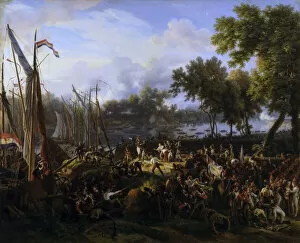Baron 1775 1848 Collection
Baron Louis-Francois Lejeune (1775-1848) was a renowned artist and military officer who left an indelible mark on the history of warfare
For sale as Licensed Images
Choose your image, Select your licence and Download the media
Baron Louis-Francois Lejeune (1775-1848) was a renowned artist and military officer who left an indelible mark on the history of warfare. His artistic prowess captured some of the most significant battles and moments in European history, showcasing his talent for immortalizing the chaos and heroism that unfolded on the battlefield. One such masterpiece is "The Battle of Pyramids, " painted in 1798, which depicts Napoleon Bonaparte's triumph over Egyptian forces. Lejeune's brushstrokes vividly portray the intensity of this clash, highlighting Napoleon's strategic brilliance. In 1800, Lejeune again showcased his skill with "The Battle of Marengo. " This painting captures the decisive moment when French troops under General Desaix turned defeat into victory against Austrian forces. The artwork encapsulates both desperation and hope as soldiers fight amidst smoke-filled chaos. Lejeune also depicted iconic events like "The Battle of Lodi" in 1796, where Napoleon crossed a bridge under enemy fire to secure victory. His portrayal emphasizes bravery and determination amid adversity. "The French Army Crossing the Rhine at Dusseldorf" showcases another pivotal moment in European history: France's successful invasion across one of Europe's greatest rivers. Through his artistry, Lejeune immortalizes this audacious feat that solidified France as a dominant power. Not limited to battle scenes alone, Lejeune also captured historical events like Charles X's entry into Paris after his consecration in 1825. This painting demonstrates Lejeune’s versatility as an artist by capturing grandeur outside military contexts. Among his other notable works are depictions of Napoleonic bivouacs before Austerlitz and battles such as Barrosa and Borodino. These paintings reveal not only Lejeune’s technical mastery but also provide glimpses into key moments that shaped Europe during this tumultuous era.











